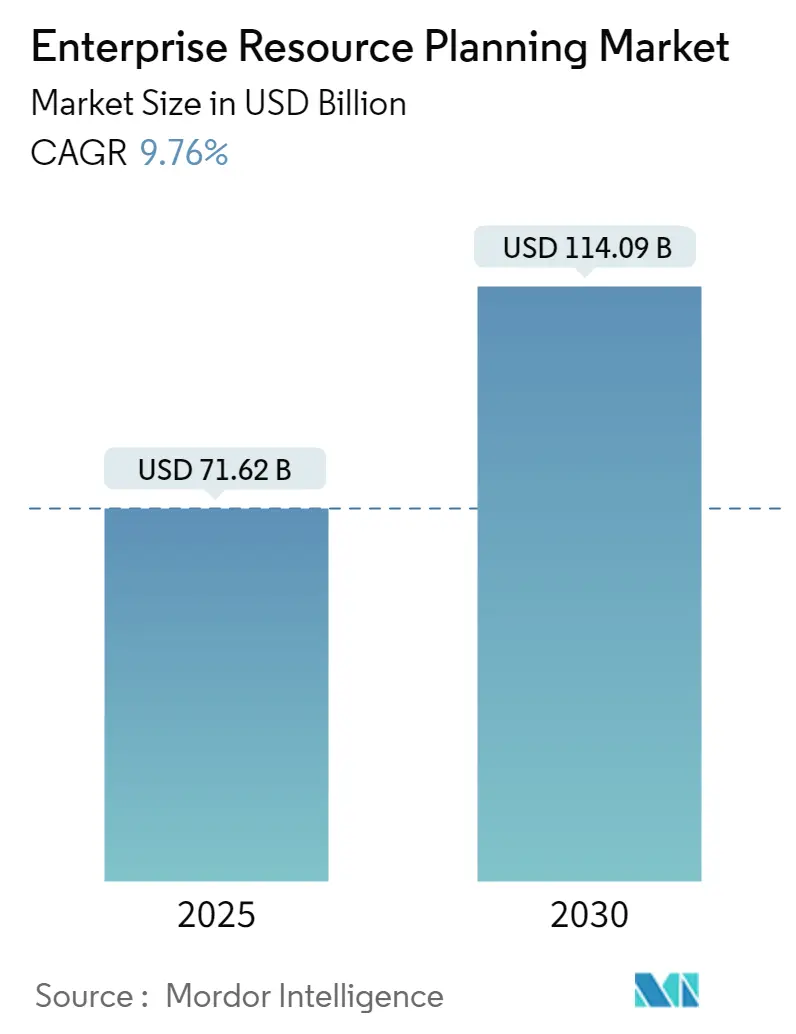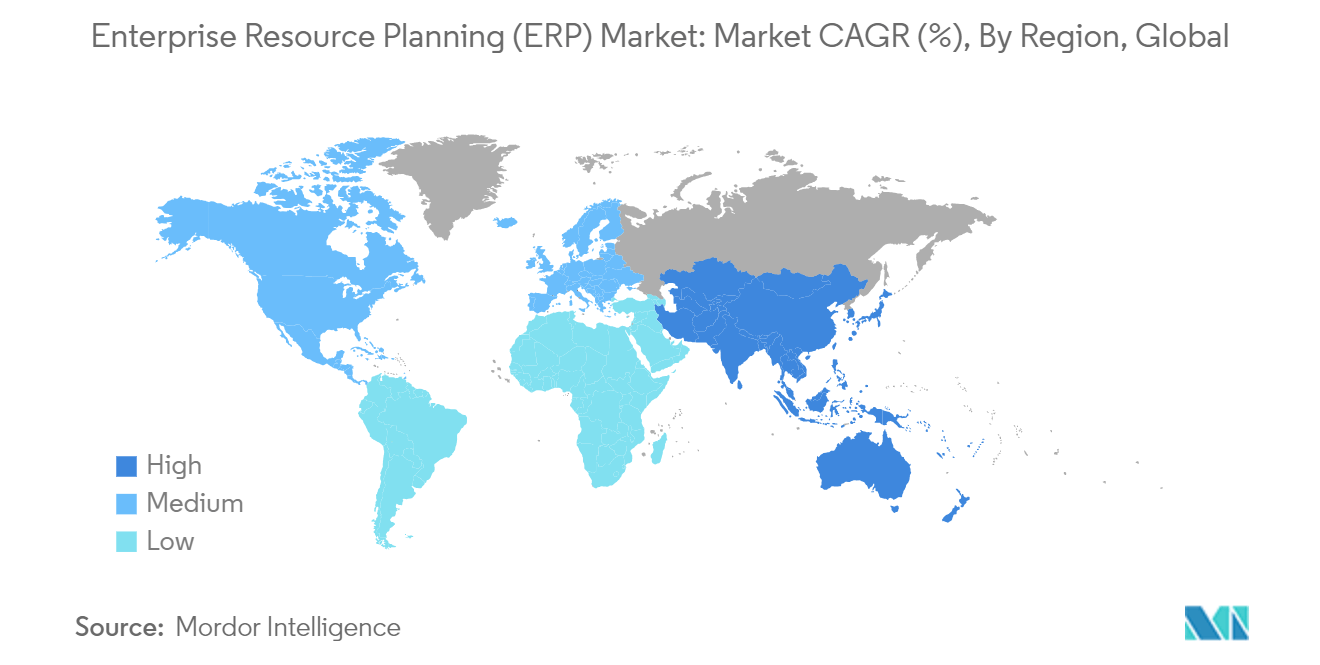Enterprise Resource Planning Market Analysis
The Enterprise Resource Planning Market size is estimated at USD 71.62 billion in 2025, and is expected to reach USD 114.09 billion by 2030, at a CAGR of 9.76% during the forecast period (2025-2030).
- ERP software aids in planning, budgeting, forecasting, and reporting an organization's financial results. Due to a steep surge in the number of businesses worldwide and the requirement for cloud-based ERP platforms, the growing need for supplier-relationship management and customer-relationship management is augmenting the market's growth.
- The increasing adoption of innovative and advancing technologies is broadening the value of existing ERP systems, minimizing third-party dependencies, advancing highly secured resources, and advancing financial systems, among other notable factors driving the demand for ERP software, especially cloud-based.
- The growing need for a customer-centric strategy partly drives the enterprise resource planning (ERP) market. Businesses increasingly realize how crucial it is to put the customer at the heart of their operations to increase customer satisfaction, loyalty, and overall business success. ERP systems are essential to reaching this objective because they offer a full range of integrated applications that let businesses increase productivity, optimize workflows, and provide better customer service.
- Demand for mobile-friendly ERP solutions has increased due to the widespread use of mobile devices. By enabling people to approve workflows, access vital company data, and make decisions while on the move, mobile ERP apps help improve operational agility. For instance, users of smartphones or tablets can access essential ERP capabilities with SAP ERP mobile apps. This facilitates real-time decision-making, improves teamwork, and increases adaptability to shifting company needs.
- ERP systems that aren't flexible may find it difficult to evolve and adapt as businesses alter or expand. This restriction may make it more difficult for companies to introduce new product lines, enter new markets, or adapt to organizational structure changes. For instance, a business that is expanding quickly could find it difficult to scale its ERP system to handle higher transaction volumes, which could cause problems with performance and create bottlenecks in the business.
- The rise of the" business online" concept in the post-COVID-19 era increases the demand for contactless transactions, making manufacturing SMEs struggle to compete. This has created the need for ERP for manufacturing companies to enable them to run all activities in real time.
Enterprise Resource Planning Market Trends
The Small and Medium-sized Enterprises Segment is Expected to Witness Highest Growth in the Market
- SMEs are enterprises that have an employee size of fewer than 250 employees. ERP implementations have made it easier and less expensive for small and medium-sized businesses to use business process automation and integration. Scalable and flexible ERP software gives small and medium enterprises access to highly integrated applications. The ERP system for SMEs directly impacts cost savings and operational improvements, helping them achieve desired business outcomes.
- Small businesses rapidly shift to ERP automation, including digital scheduling and analysis. The emergence of ERP software and services over the last decade has made business operations easier. SMEs have been embracing ERP software to streamline and automate processes, eliminating the need for manual input.
- Benefits like ease of workflow, less turnaround time, and high production capability provide transparency, allowing managers to gain better insights and make effective decisions. It provides SMEs with real-time financial data that offers a competitive advantage and helps ensure cost savings.
- In May 2024, Forterro, a European ERP software provider for the industrial mid-market, announced the UK launch of Fortee, its entry-level cloud-based ERP solution. Designed as an out-of-the-box SaaS solution, Fortee targets organizations new to ERP adoption. Drawing from the foundation of Forterro's cloud ERP, Sylob, Fortee is tailored to focus on key functionalities for its intended audience, including procurement, production, CRM, and supply chain management.
- Small and medium enterprises across the world acknowledge the benefits of digital transformation, which drives the transition to cloud-based ERP solutions to meet their budget and business needs. The increasing demand to streamline complex processes and respond to customer demands more quickly would likely boost market adoption in the segment studied.
North America is Expected to Hold the Largest Share in the Market
- The most popular ERP solutions in the United States include Oracle NetSuite, Oracle ERP Cloud, and Microsoft Dynamics 365. The increasing adoption of ERP software in the United States is attributed to large enterprises such as Oracle and Microsoft and the need for businesses to gain a competitive edge in the market by integrating business functions.
- Moreover, these companies provide ERP software solutions built for mid and large-sized companies to assist them in complex functions such as finance and operations. Many providers offer mature ERP solutions owing to their decades of expertise and industry knowledge, promoting demands for such solutions in the United States.
- ERP solutions such as Oracle Netsuite, Oracle ERP Cloud, Microsoft D365, and Acumatica target small and mid-market companies looking to upgrade their basic accounting system and evolve through digital transformation. Others have defined a prominent niche in the marketplace, focusing on manufacturing distribution organizations and offering cost-effective solutions with a very high return on investment (ROI).
- Moreover, in July 2023, San Francisco-based Evergreen Services Group, a private equity-backed family of managed IT solutions companies, acquired Western Computer, a Microsoft Gold Cloud partner and reseller of Microsoft’s ERP systems. The acquisition was part of Evergreen Services Group’s strategy to acquire B2B services companies across the United States.
- ERP software benefits Canadian organizations by reducing duplicated data entry by integrating business processes. Increasing customer demand to reduce time and increase the accuracy of business functionalities is driving the need for ERP solutions in Canada. Toronto and Montreal are rising as central hubs for business and tech advancements in Canada. These areas are witnessing many established and emerging players in the regional ERP market.
Enterprise Resource Planning Industry Overview
The enterprise resource planning (ERP) market is semi-consolidated, with many regional and global players. Market vendors focus on expanding their customer base across foreign countries and leveraging strategic collaborative initiatives to increase the market's share and profitability. Some players include SAP SE, Intuit, Microsoft Corporation, and Constellation Software.
- May 2024: Amazon Web Services (AWS) and SAP expanded their existing partnership to introduce generative AI capabilities that can integrate into functions across entire business portfolios. The expansion will allow companies using SAP software like Zappos to access generative AI toolsets within the cloud-based enterprise resource planning (ERP) platform.
- April 2024: Nuvei introduced a service allowing merchants to directly access its invoice financing solutions via enterprise resource planning (ERP) systems. This integration ensures that the system automatically mirrors loan and repayment entries in the general ledger, aligning them with the respective financed invoice.
Enterprise Resource Planning Market Leaders
-
Microsoft Corporation
-
SAP SE
-
Intuit
-
Constellation Software
-
FIS
- *Disclaimer: Major Players sorted in no particular order
Enterprise Resource Planning Market News
- February 2024: Mesh Payments integrated its global card and spend management solution with NetSuite OneWorld, an enterprise resource planning (ERP) system for multi-subsidiary management. This integration improves global spend management by simplifying intercompany transfers and ensuring seamless transaction synchronization across diverse entities.
- January 2024: One Network Enterprises (ONE), a global provider of intelligent control towers and the Digital Supply Chain Network, announced the release of its NEO Defense Enterprise Solution. The solution is an enterprise resource planning (ERP) system for international defense organizations and worldwide military operations. In addition to over 300 organic applications, the solution natively supports key defense capabilities such as management of munitions and guided weapons, food service, bulk fuels, medical supplies, and sparing across supply, transportation, and maintenance functions.
Enterprise Resource Planning Industry Segmentation
Software programs that integrate multiple company processes and operations into a unified platform are called enterprise resource planning or ERP. These processes include manufacturing, supply chain management, finance, and human resources.
The enterprise resource planning (ERP) market is segmented by offering (solutions and services), function (HR, supply chain, finance, marketing, and other functions), deployment (on-premise and hybrid), organization size (small and medium enterprises and large enterprises), industry verticals (BFSI, IT and telecom, government, retail and e-commerce, manufacturing, oil, gas, and energy, and other industry verticals), and geography (North America, Europe, Asia-Pacific, Latin America, and Middle East and Africa). The report offers the market size and forecasts for all the above segments in value (USD).
| By Offering | Solutions | ||
| Services | |||
| By Function | HR | ||
| Supply Chain | |||
| Finance | |||
| Marketing | |||
| Other Functions | |||
| By Deployment | On-premise | ||
| Hybrid | |||
| By Organization Size | Small and Medium Enterprises | ||
| Large Enterprises | |||
| By Industry Verticals | BFSI | Use Cases | |
| IT and Telecom | Use Cases | ||
| Government | Use Cases | ||
| Retail and E-commerce | Use Cases | ||
| Manufacturing | Use Cases | ||
| Oil, Gas, and Energy | Use Cases | ||
| Other Industry Verticals | Use Cases | ||
| By Geography*** | North America | ||
| Europe | |||
| Asia-Pacific | |||
| Latin America | |||
| Middle East and Africa | |||
Enterprise Resource Planning (ERP) Market Research FAQs
How big is the Enterprise Resource Planning Market?
The Enterprise Resource Planning Market size is expected to reach USD 71.62 billion in 2025 and grow at a CAGR of 9.76% to reach USD 114.09 billion by 2030.
What is the current Enterprise Resource Planning Market size?
In 2025, the Enterprise Resource Planning Market size is expected to reach USD 71.62 billion.
Who are the key players in Enterprise Resource Planning Market?
Microsoft Corporation, SAP SE, Intuit, Constellation Software and FIS are the major companies operating in the Enterprise Resource Planning Market.
Which is the fastest growing region in Enterprise Resource Planning Market?
Asia Pacific is estimated to grow at the highest CAGR over the forecast period (2025-2030).
Which region has the biggest share in Enterprise Resource Planning Market?
In 2025, the North America accounts for the largest market share in Enterprise Resource Planning Market.
What years does this Enterprise Resource Planning Market cover, and what was the market size in 2024?
In 2024, the Enterprise Resource Planning Market size was estimated at USD 64.63 billion. The report covers the Enterprise Resource Planning Market historical market size for years: 2019, 2020, 2021, 2022, 2023 and 2024. The report also forecasts the Enterprise Resource Planning Market size for years: 2025, 2026, 2027, 2028, 2029 and 2030.
Our Best Selling Reports
ERP Software Industry Report
The Global Enterprise Resource Planning (ERP) Market is witnessing remarkable growth, fueled by the need for operational efficiency and streamlined business processes in various sectors. This surge is largely due to digital transformation, pushing organizations to adopt ERP software to enhance decision-making, improve transparency, and foster data-driven strategies. The ERP market size is expanding, with a notable shift towards cloud-based solutions, especially among small and medium-sized enterprises, to cut costs and boost competitiveness. Mobile and cloud applications are elevating the ERP software market, offering flexibility for businesses to access data and manage operations remotely. The market caters to diverse business functions like financial management and supply chain management, with significant adoption in manufacturing, Banking, Financial Services and Insurance (BFSI), IT & telecom, and healthcare sectors to optimize processes. Key regions like North America, Europe, and the Asia Pacific are at the forefront of ERP software adoption, Due to technological advancements. Current ERP software trends focus on enhancing user experience, integrating cutting-edge technologies, and providing industry-specific solutions, addressing the evolving needs of global businesses. For detailed insights, Mordor Intelligence™ offers a comprehensive analysis, including market share, size, revenue growth rate, and a forecast outlook, available as a free report PDF download.

_Market__comapny_logo.webp)



_Market_competive_logo.webp)

